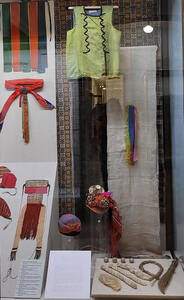Silk in the Russian Costume of the Southern Regions

Silk in the Russian Costume of the Southern Regions
Since the mid-19th century, silk threads and fabrics were actively used to decorate peasant clothes in the southern regions of Russia. Until the 20th century, items of the South Russian women’s poneva woolen skirt costume sets were made of home-produced fabrics; while adornments incorporated silk threads, ribbons, webbing, and fabric cuts. In the Belgorod County of the Voronezh Governorate, young women extensively decorated their festive ponevas material with light brown threads of raw silk; multicolor silk threads were used to embroider forehead parts (ochelias) of the Ryazan soroka headdresses and the Tambov flap hems; silk threads were also used to weave cords and webbing for neck and breast adornments. Silk ribbons were also widely used to decorate garments, like ponevas, aprons and nagrudniks, as well as headdresses. Thus, silk adorned girl’s headbands; in some regions, a girl’s headdress was as simple as a silk headscarf folded diagonally. Silk threads and ribbons also decorated kots – peasant women’s shoes. Sure enough, silk headscarves were an essential part of the festive costume set of a young peasant woman.
Silk in the Traditional Culture of Podniprovie and Podolia
In the 19th – early 20th centuries, small sericulture farms appeared in the Kiev, Poltava, Podolia, and Chernihiv Governorates. However, this production type did not become widespread in the region, in particular due to the impossibility of large-scale cultivation of mulberries.
In their majority, silk fabrics used for interior decor items and clothing were still imported from Europe or other provinces of the Russian Empire, which increased their cost. Wealthy people could afford larger silk pieces, while less affluent population groups had to settle for small silk elements in festive costumes: ribbons, webbing, and silk thread embroidery. Women’s headdresses were decorated with silk: satin ribbons adorned maidens’ wreaths, decorated ochipoks of married women. Women’s festive clothes were made of satin: vests, sleeveless jackets, while silk thread embroidery decorated headscarves, plakhta fabric, shirts, and towels.
1. Part of poneva homespun woolen skirt. Verkhososensk Village, Biryuch County, Voronezh Governorate. 2nd half of the 19th century. Russians
2. Ribbon. Bolshoy Izberdey Village, Lipetsk County, Tambov Governorate. Late 19th century. Russians
3. Women’s headgear ribbons. Ryazan Governorate. Late 19th century. Russians
4. Venets girl’s headgear. Ivot Village, Bryansk County, Orlov Governorate. Early 19th century. Russians
5. Lopasti part of girl’s headgear. Kirsanov County, Tambov Governorate. Last quarter of the 19th century. Russians
6. Soroka women’s headgear. Konoplyanka Village, Kirsanov County, Tambov Governorate. Last quarter of the 19th century. Russians
7. Women’s headgear. Podgornoye Village, Ranenburg County, Ryazan Governorate. Last third of the 19th century. Russians
8. Soroka women’s headgear. Losha Village, Pronsk County, Ryazan Governorate. Last third of the 19th century. Russians
9. Podzatylnik, part of women’s headgear. Zolotovka Village, Kirsanov County, Tambov Governorate. Last quarter of the 19th century. Russians
10. Women’s waist wear. Chernihiv Governorate. Last quarter of the 19th century. Ukrainians
11. Part of a married woman’s headwear. Kiev Governorate. Late 19th century. Ukrainians
12. Women’s sleeveless jacket. Kursk Governorate. Late 19th – early 20th century. Ukrainians
13. Hair ribbons. Podolia Governorate. Late 19th – early 20th century. Moldovans
14. Women’s wedding headwear. Siedlce Governorate. Late 19th – early 20th century. Ukrainians
15. Married woman’s headwear. Kharkov Governorate. 2nd half of the 19th century. Ukrainians
16. Silk thread samples, raw silk samples. Kiev Governorate. Late 19th century. Ukrainians
17. Tools for silkworm cocoon boiling. Kiev Governorate. Late 19th century. Ukrainians
18. Women’s belt. Podolia Governorate. Late 19th – early 20th century. Moldovans



